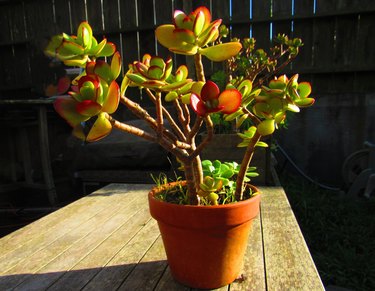
Like the precious stone for which the succulent is named, the jade plant (Crassula ovata) is a lifetime treasure passed down from one generation to the next. This houseplant with puffy, oval leaves looks cute, but it will outlive you! It can live a century or more, bringing—according to legend—good luck and good fortune to your home. With fleshy green leaves and woody stems, mature jade plants look like little trees.
All succulents are drought-tolerant and resilient, and the jade plant is no exception. It falls into the category of "very little maintenance required" as long as you give it well-draining soil, some sun and water from time to time. A jade plant can be a houseplant for life.
Video of the Day
Video of the Day
Crassula ovata
- Easy Care: Yes!
- Light + Location: Partial shade to direct sunlight
- Watering: Water in the growing season when soil has dried out
- Growth Rate: Slow-growing
- USDA Zones: 10-11
- Flowering: White star-shaped flowers but not a reliable bloomer indoors
- Pet-Safe: No! Toxic to dogs and cats.
All About the Jade Plant
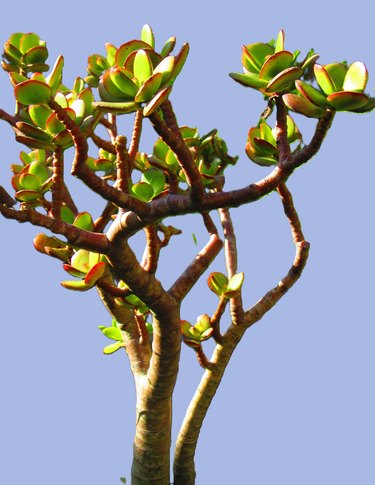
People ask me all the time if my little jade houseplant is a bonsai. It's easy to see why. The jade plant looks like a little tree with coin-size, puffy leaves and a miniature, treelike trunk. The foliage is dark green, and in intense sun, the leaves develop red around the edges.
Jade plants can grow outside in warmer zones; my yard in San Francisco has more than a few. But, like most succulents, they don't tolerate cold, and a single frost will probably kill them. However, they are mostly seen as houseplants, and they grow well indoors.
In Asian cultures, jade plants are thought to represent good luck and are said to bring success and wealth into the family. For this reason, the plant is sometimes called the "money plant" or "money tree." This comes from feng shui, an ancient Chinese spiritual practice that links jade plants with good fortune. In these cultures, jade plants are a common gift for new business owners.
Despite all of these associations, don't bank on it. I keep a half-dozen jade plants in the house, but I still keep my day job. However, having these easy-care plants is guaranteed to make it more pleasant to work at home!
Types of Jade Plants
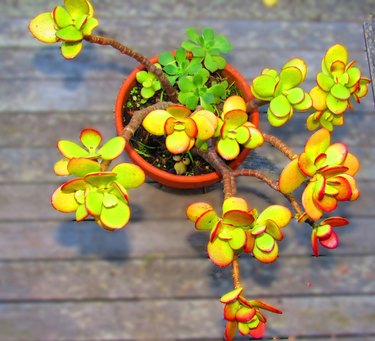
Jade plants are such popular houseplants that many cultivars have been developed. A few common choices are:
Variegata (Crassula ovata 'Variegata'): The leaves on this cultivar have ivory and cream variegations, giving it the nickname "tricolor jade." It grows even more slowly than regular jades and will not tolerate direct sun.
Compact (Crassula ovata 'Crosby's Campact'): This little plant never grows taller than 18 inches and has smaller, denser leaves.
Sunset (Crassula ovata 'Hummel's Sunset'): There are tones of red, yellow and orange in the green of these jades, especially in chillier regions. Often, the color is found around the leaf edges.
Hobbit: (Crassula ovata 'Hobbit'): This unusual cultivar has leaves that curl in, said to look like hobbit fingers. It grows to 3 feet tall.
Care and Feeding of a Jade Plant
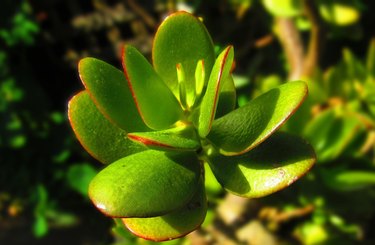
Jade is one of the easiest-care houseplants you will ever come across. Given its drought-tolerant ways and slow growth, it is an ideal windowsill plant. Get it appropriately situated in well-draining soil and indirect sunlight and you may even forget it is a living plant.
But that only works if you meet the plant's basic cultural requirements. Let's go over the core elements that the plant needs to thrive.
Best Location for a Jade Plant
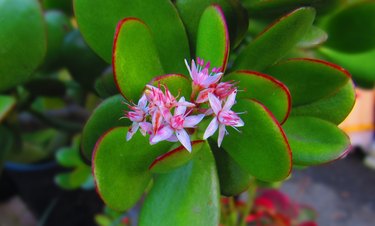
My outdoor jade plants grow happily in a full-sun location, but remember: This is in San Francisco, where fog softens even the sunniest day. Generally, an indoor jade plant likes dappled sunlight or bright, indirect sunlight. It won't die in low light, but it may get leggy and will rarely have the delicate, starry blossoms. The best place for your jade is on the sill of a south-facing or west-facing window.
Potting Soil for a Jade Plant
You can find cactus/succulent soil at the plant store, and this works well for a jade plant. But you don't have to go that far. Use ordinary potting soil with some perlite or sand mixed in for extra drainage.
Air Temperature and Humidity for a Jade Plant
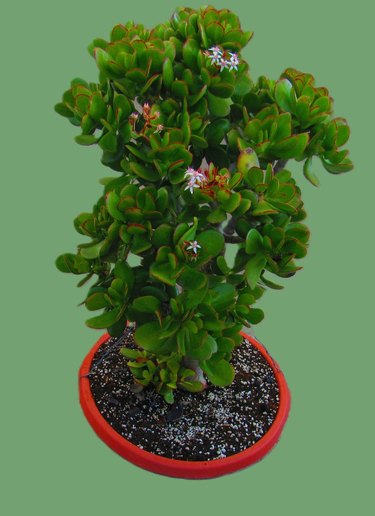
A consistent temperature is important to a jade plant. Don't find out the consequences by trial and error like I did! As long as you keep your jade away from a heater or air conditioner, average household temperatures of 60° to 75°F will keep your jade plant happy. Those in cold-winter locations should move jade plants away from windows.
Watering Your Jade Plant
Overwatering a jade can give it deadly root rot. Overwatering is usually due to soil that doesn't drain well, but it can also involve too much water. The soil in the jade plant container should be dry before you water again. For me, that means watering my jades every two or three weeks.
Best Fertilizer for a Jade Plant
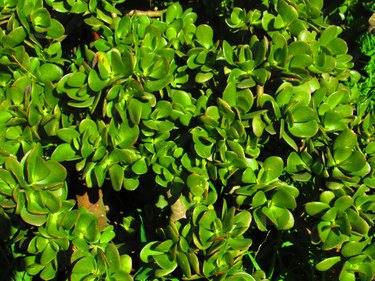
Yes, you can fertilize your jade plant if that pleases you, but you don't have to offer these succulents extra nutrients. I never fertilize mine—either those indoors or those outdoors—and they grow perfectly well. If you want to fertilize, buy a balanced liquid fertilizer and use it once or twice during the growing season.
Propagating and Transplanting Jade Plants
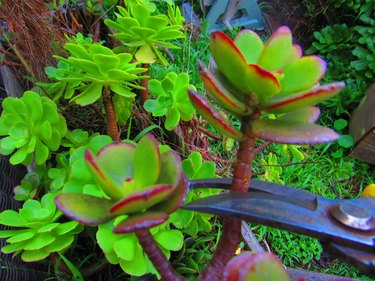
Propagating a jade plant is such a sure thing that it's easy to get carried away. Don't make the same mistake that I did and start a couple dozen plants! You won't have the window space to hold them all.
But it's tempting since jade plants root from stem cuttings and also leaf cuttings. You propagate them essentially in the same way. For my part, I have a 100% success rate with propagation. Here's how:
- Snip or twist off a leaf or a small stem of the plant.
- Let the cut section callous off by leaving it sitting out in the shade somewhere for a few days. This prevents rot.
- Prepare a tray (for leaves) or a small pot (for stems) of moist soil. Set the calloused end of the leaf in the tray soil or, if you took a stem, plunge the bottom inch of the jade stem into the soil.
- Place the tray or pot in a spot with indirect light. Spray the soil with water every other day to keep it moist. The leaf or stem will root in a matter of days. Keep the soil moist as the roots develop. When new leaves are evident, transplant the jade into another pot.
Repotting Your Jade Plant
Jade plants do not outgrow their pots very quickly. If you see roots protruding from the container's drain holes, repotting into a slightly larger pot is in order. Tip the soil ball out of the pot and take a look. If the plant is rootbound, loosen the roots and pot it in a container that is an inch or so bigger than the former pot.